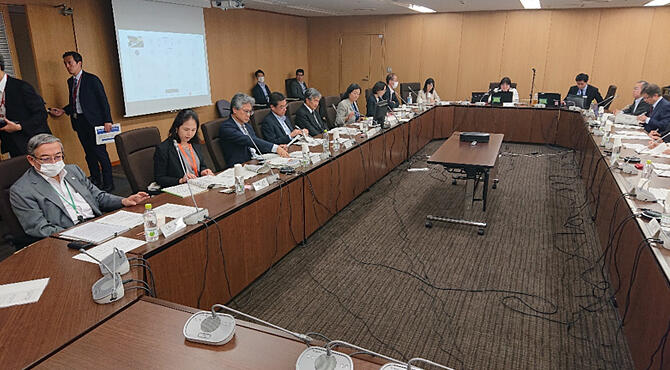In Japan, the research infrastructure to promote genome research, including the entire genome data, has almost been established. However, genome research needs to be guided to drug discovery and other therapeutic deliverables in order to realize genomic and personalized medicine. President Yoshinao Mishima of the Japan Agency for Medical Research and Development (AMED) has committed to establishing a new three-year continuing financial support system that is expected to spur research on the pathogenesis of diseases as well as the development of therapeutic drugs. The system capitalizes on the Medical Research and Development-related Promotional Adjustment Funds. Mishima is also promoting research partnership among scientists in various industries and fields where they can make maximum use of fundamental technologies and basic sciences, in addition to genome data. The decision will be officially taken at a coming meeting of the Headquarters for Healthcare Policy.

Out of the 55.5 billion JPY from the Cabinet Office's Science and Technology Innovation Creation and Promotion Funds, 17.5 billion JPY is to be allocated as Research and Development-related Promotional Adjustment Funds for medical fields, and there are two types of funds: the President's discretionary funds, which responds to the needs and contingencies on site, and the top−down funds, which encompasses a flexible budget managed by the Headquarters. At the June 13 meeting of the Promotion Council for the Healthcare Policy, the first set of allocation proposals of the Funds was presented for the current fiscal year. A total of 11.65 billion JPY will be reserved as the President's discretionary funds for 143 projects, in accordance with the five President's policies.
The Funds are earmarked for projects that have progressed more successfully than originally planned and can be expected to lead to further development and even commercialization by accelerating R&D through additional funding. The Funds were designed to be allocated only for a single fiscal year. However, for strengthening R&D that will lead genome research to drug discovery and other deliverables, Mishima has proposed a new system under which the Program Supervisor (PS)/Program Officer (PO) take the responsibility of project management up to the succeeding two fiscal years, and researchers can spend them smoothly as needed from the beginning of each fiscal year.
Mishima commented, "The progress in this field is very rapid, and Japan is falling behind the rest of the world. Some research can be addressed through the conventional budget process of making a budget request for the following fiscal year and then being included in the budget for that year. However, some research cannot wait even one year, and missing opportunities would put Japan further behind the curve. We hope to break through the current situation by investing funds in a flexible manner."
Analytical technologies applied in genome research across the world are advancing so quickly that they will be improved or innovated within a few months, and the technology gap between Japan and Western countries is widening. The present is a defining moment, and a new funding system must be developed by adopting a flexible approach that takes advantage of the coordinating nature of the Funds. To quickly demonstrate a typical model in which research results could lead to drug discovery, AMED will open a new call for applications soliciting new research teams in cross-disciplinary collaborations.
Bringing together researchers from different fields, including genome, clinical medicine/pathology, AI and drug discovery, the project aims to seamlessly link different stages of research using the latest technologies to provide deliverables that lead to drug discovery. The project will also pursue pathological analysis efficiently by using the latest technologies, which provide new types of data: spatial and temporal variations of biological activities at the cellular level, multiomics (e.g., transcriptomics, proteomics and metabolomics), imaging (e.g., MRI and CT), and clinical data. The research period is assumed to be approximately three years, and the Funds are to be disbursed every fiscal year during that term. For the second and third years, based on the evaluation of progress by the PS and PO, the need for the Funds will be taken into consideration and the necessary funds will be made available without delay at the beginning of the fiscal year.
In addition to the above, the projects financially supported by the current allocations from the Funds include the following: 37 projects (under the goal of increasing cooperation among projects, themes and fields through the use of basic technologies and research centers), such as (1) the development of Japan-originated drugs for central nervous system diseases through the collaboration between Science and Technology Platform Program for Advanced Biological Medicine and Project for Advanced Drug Discovery and Development and (2) the improvement of the infrastructure of postmortem brain resource for mental and nervous system disorders by the Japan Brain Bank Net (JBBN); five projects reserved for young researchers, aimed at the development of novel anticancer drugs targeting the functional domain of histone demethylase LSD1 in intractable and treatment-resistant cancers; seven projects for strengthening international collaboration, including international clinical research to specify the dietary habits and intragastric environment that contributes to controlling Helicobacter pylori-associated gastric carcinogenesis in Japan and Lithuania; and 92 projects related to the improvement of R&D equipment and facilities, including the development of an integrated drug discovery AI platform that combines multi-target prediction and structural generator using state-of-the-art AI technologies.
This article has been translated by JST with permission from The Science News Ltd. (https://sci-news.co.jp/). Unauthorized reproduction of the article and photographs is prohibited.




